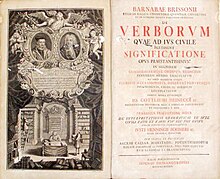In linguistics, declension is the changing of the form of a word, generally to express its syntactic function in the sentence, by way of some inflection. Declensions may apply to nouns, pronouns, adjectives, adverbs, and determiners to indicate number, case, gender, and a number of other grammatical categories. Meanwhile, the inflectional change of verbs is called conjugation.
A grammatical case is a category of nouns and noun modifiers that corresponds to one or more potential grammatical functions for a nominal group in a wording. In various languages, nominal groups consisting of a noun and its modifiers belong to one of a few such categories. For instance, in English, one says I see them and they see me: the nominative pronouns I/they represent the perceiver and the accusative pronouns me/them represent the phenomenon perceived. Here, nominative and accusative are cases, that is, categories of pronouns corresponding to the functions they have in representation.

Latin is a classical language belonging to the Italic branch of the Indo-European languages. Considered a dead language, Latin was originally spoken in Latium, the lower Tiber area around Rome. Through the expansion of the Roman Republic it became the dominant language in the Italian Peninsula and subsequently throughout the Roman Empire. Even after the fall of Western Rome, Latin remained the common language of international communication, science, scholarship and academia in Europe until well into the early 19th century, when regional vernaculars supplanted it in common academic and political usage. For most of the time it was used, it would be considered a dead language in the modern linguistic definition; that is, it lacked native speakers, despite being used extensively and actively.

Neo-Latin is the style of written Latin used in original literary, scholarly, and scientific works, first in Italy during the Italian Renaissance of the fourteenth and fifteenth centuries, and then across northern Europe after about 1500, as a key feature of the humanist movement. Through comparison with Latin of the Classical period, scholars from Petrarch onwards promoted a standard of Latin closer to that of the ancient Romans, especially in grammar, style, and spelling. The term Neo-Latin was however coined much later, probably in Germany in the late 1700s, as Neulatein, spreading to French and other languages in the nineteenth century. Medieval Latin had diverged quite substantially from the classical standard and saw notable regional variation and influence from vernacular languages. Neo-Latin attempts to return to the ideal of Golden Latinity in line with the Humanist slogan ad fontes.

English plurals include the plural forms of English nouns and English determiners. This article discusses the variety of ways in which English plurals are formed from the corresponding singular forms, as well as various issues concerning the usage of singulars and plurals in English. For plurals of pronouns, see English personal pronouns.
In grammar, the locative case is a grammatical case which indicates a location. It corresponds vaguely to the English prepositions "in", "on", "at", and "by". The locative case belongs to the general local cases, together with the lative and separative case.
The toponymy of England derives from a variety of linguistic origins. Many English toponyms have been corrupted and broken down over the years, due to language changes which have caused the original meanings to be lost. In some cases, words used in these place-names are derived from languages that are extinct, and of which there are no known definitions. Place-names may also be compounds composed of elements derived from two or more languages from different periods. The majority of the toponyms predate the radical changes in the English language triggered by the Norman Conquest, and some Celtic names even predate the arrival of the Anglo-Saxons in the first millennium AD.
International scientific vocabulary (ISV) comprises scientific and specialized words whose language of origin may or may not be certain, but which are in current use in several modern languages.
Fusional languages or inflected languages are a type of synthetic language, distinguished from agglutinative languages by their tendency to use a single inflectional morphemes to denote multiple grammatical, syntactic, or semantic features.
English is a West Germanic language that originated from Ingvaeonic languages brought to Britain in the mid-5th to 7th centuries AD by Anglo-Saxon migrants from what is now northwest Germany, southern Denmark and the Netherlands. The Anglo-Saxons settled in the British Isles from the mid-5th century and came to dominate the bulk of southern Great Britain. Their language originated as a group of Ingvaeonic languages which were spoken by the settlers in England and southern and eastern Scotland in the early Middle Ages, displacing the Celtic languages that had previously been dominant. Old English reflected the varied origins of the Anglo-Saxon kingdoms established in different parts of Britain. The Late West Saxon dialect eventually became dominant. A significant subsequent influence on the shaping of Old English came from contact with the North Germanic languages spoken by the Scandinavian Vikings who conquered and colonized parts of Britain during the 8th and 9th centuries, which led to much lexical borrowing and grammatical simplification. The Anglian dialects had a greater influence on Middle English.
In English, the plural form of words ending in -us, especially those derived from Latin, often replaces -us with -i. There are many exceptions, some because the word does not derive from Latin, and others due to custom. Conversely, some non-Latin words ending in -us and Latin words that did not have their Latin plurals with -i form their English plurals with -i, e.g., octopi is sometimes used as a plural for octopus. Prescriptivists consider these forms incorrect, but descriptivists may simply describe them as a natural evolution of language.
A feature common to all Indo-European languages is the presence of a verb corresponding to the English verb to be.

Linguistic purism or linguistic protectionism is the prescriptive practice of defining or recognizing one variety of a language as being purer or of intrinsically higher quality than other varieties. Linguistic purism was institutionalized through language academies, and their decisions often have the force of law.

Latin is a member of the broad family of Italic languages. Its alphabet, the Latin alphabet, emerged from the Old Italic alphabets, which in turn were derived from the Etruscan, Greek and Phoenician scripts. Historical Latin came from the prehistoric language of the Latium region, specifically around the River Tiber, where Roman civilization first developed. How and when Latin came to be spoken has long been debated.

Gothic is an extinct East Germanic language that was spoken by the Goths. It is known primarily from the Codex Argenteus, a 6th-century copy of a 4th-century Bible translation, and is the only East Germanic language with a sizeable text corpus. All others, including Burgundian and Vandalic, are known, if at all, only from proper names that survived in historical accounts, and from loanwords in other, mainly Romance, languages.
Common Brittonic, also known as British, Common Brythonic, or Proto-Brittonic, is an extinct Celtic language spoken in Britain and Brittany.
In Sweden, a person must have a surname and one or more given names. Two given names are common. Surnames are inherited from the parents, in the order of "same as elder sibling, if any; specified by parents; or mother's last name," while given names must be chosen by the parents at birth. The calling name by which the person is normally identified in conversation, is in Scandinavian countries one of the given names, not necessarily the first. In contexts where the full name is spelled out, the calling name is often indicated by an asterisk, by capital letters, or underlines or italics. For example, Märta Birgit* Nilsson is known as Birgit Nilsson, while Björn* Kristian Ulvaeus is known as Björn Ulvaeus.
The declension of nouns in Latin that are borrowed from Greek varies significantly between different types of nouns, though certain patterns are common. Many nouns, particularly proper names, in particular, are fully Latinized and declined regularly according to their stem-characteristics. Others, however, either retain their Greek forms exclusively, or have the Greek and Latin forms side by side. These variations occur principally in the singular; in the plural the declension is usually regular. Note, however, that many Greek names of the third declension in Latin pass over into the first declension in the plural; as, Thūcȳdidās, Hyperīdae, and many names in -crates.






